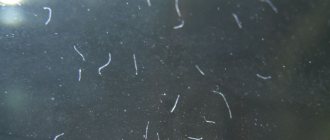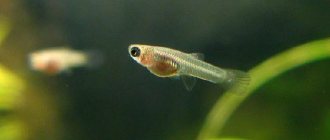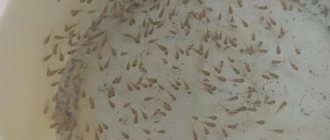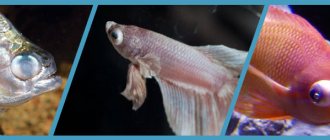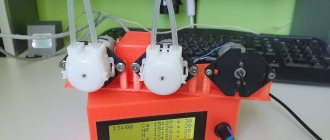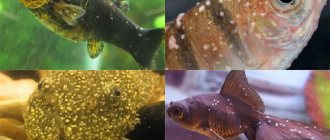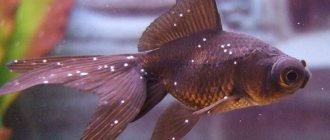Post Views: 436
5
(2)
Nematodes or roundworms are a type of protostomes from the molting group. Currently, more than 24 thousand species of parasitic and free-living nematodes have been described. Free-living nematodes live in soil, fresh water and the sea, where their numbers can exceed 1 million individuals per 1 m3. They play an important role in ecosystems. Cultivated nematodes are small (1-2 mm long), spindle-shaped worms that move by bending their entire body. In the aquarium hobby, these worms are called microfood or microworms. Used as food for fry and small fish species. Breeding nematodes at home is not difficult, worms are not demanding, but there are some nuances.
container with nematode
Nematode conditions
Comfortable temperature is from 20 to 28 degrees, the lower it is, the lower the reproduction rate. They are diluted in bowls, plates, cuvettes, and containers made of glass and plastic. They eat all kinds of cereals made from rolled oatmeal, oatmeal or barley flour, with a small addition of milk; you don’t have to use milk, but the nutritional value of the worm decreases accordingly. You can also add grated carrots or carrot juice, multivitamins. It is well diluted on a gruel consisting of white bread or loaf and milk. Containers are kept in shaded areas.
I breed my nematode in 1-liter plastic food containers with a lid; I don’t make holes in it for ventilation, since they already exist. The lid is needed to create a certain humidity in the container and prevent the feed mixture from drying out quickly. It also prevents the penetration of flies into the crop, which will actively reproduce and suppress the worm.
I use oatmeal as a substrate; it seems to me that it is most suitable for the nematode, it has a homogeneous structure and there are no solid particles in it that the worm cannot eat; therefore, less mold is formed and the substrate decays less often.
During normal breeding, maintaining the culture in normal condition, I prepare oatmeal porridge in water, if it is necessary to feed the nematode to the fry, or add milk, carrots to the culture, or start a new one with the addition of these ingredients.
Aquarium fish food: nematodes
GD Star Rating loading…
The class Nematoda includes more than five thousand species of worms. Among them there are both free-living species and parasites of animals and plants.
Of the free-living nematodes, representatives of the genera Panagrellus, Turbatrix (Anguillula) and Rhabditis, which are known among aquarists under the name “micra,” are cultivated for feeding fish. The methods for culturing worms of all these genera are similar, so we will describe them using the example of the species Panagrellus redivivus.
Panagrellus redivivus is a small, milky white worm with a smooth, dense cuticle. In nature, it is found in places with high humidity and a large amount of decaying organic matter.
Worms are active at temperatures from 10 degrees cold to 30 degrees hot; optimal temperatures for population growth are 22-23 degrees hot.
They prefer places with an acidic environment (pH from 3.4 to 4.2). Although these worms need a lot of moisture, they are nevertheless able to tolerate dry conditions for a long time. With subsequent moistening, the worms become active again.
Males of Panagrellus redivivus are smaller than females and have a curled tail. The development of eggs occurs in the female’s uterus and lasts 2-2.5 days. In the female, you can find embryos at all stages of development - from eggs to fully formed individuals ready for birth. Before birth, young worms move freely in the uterus. Having found a way out, they leave the female’s body. The number of embryos of the same age depends on the age and size of the female and can range from 7 to 42. At an ambient temperature of 21 degrees Celsius, the female gives birth at 1-1.5 day intervals. At this temperature, she lives to the age of 20-25 days and during this time manages to give birth to approximately 15 litters with a total number of offspring of up to 300 individuals.
Young worms grow most rapidly in the first three days, after which they reach sexual maturity. During this time, their sizes increase from 0.18-0.29 mm to 1.1-1.65 mm. The maximum length of males is 2.05 mm, females - 2.76 mm.
The body of nematodes contains 76% water and 24% dry matter, which consists of 40% protein and 19.5% fat.
Panagrellus redivivus is a convenient animal for captive culture. Worms reproduce easily, have a short life cycle and are quite resistant to adverse environmental conditions.
These worms are cultured in two ways. In the first method, they are kept in the ground, where food is added. In another method, they are cultivated directly in the feed without soil. The second method is the most convenient, as it allows for rational cultivation and facilitates the selection of bred worms.
Food for worms is prepared from oatmeal, oats, barley or vegetables, boiling them to a thick porridge. You can add a little milk to the porridge. If the porridge is liquid, then by the end of the first day it will become covered with a bacterial film, which, of course, is extremely undesirable. In such conditions, nematodes grow slowly. It is better to boil food of the required consistency in one liter of water from one of the following products: 150 grams of oatmeal, 200 grams of oatmeal, 300 grams of grain oats, 250 grams of barley flour. You need to cook for 7-10 minutes (grain oats - 40-50 minutes). Cool the cooked porridge and mix well.
To maintain a culture of nematodes, glass or plastic containers are used, which are covered with a cover glass on top. This prevents the crop from drying out, and the smell of souring feed does not spread so widely.
Nematodes colonize only the upper part of the food substrate (2-5 mm), although the layer of porridge in the container should be approximately 10-15 mm. A thinner layer dries out quickly, which is why the worm culture will have to be transferred to a new substrate more often.
How it's done? A portion of the old substrate with worms or a small amount of clean nematodes is evenly applied to the layer of fresh feed substrate. The primary planting density can be 300 pcs/cubic cm, which is achieved by adding 260-300 mg of pure culture (one-third of a teaspoon) per 0.1 square meter of container surface. With fewer worms, a significant area of the feed substrate will be occupied by various microorganisms, which will lead to its rapid deterioration.
Nematodes are cultivated at a temperature of 23-27 degrees Celsius. At such temperatures, the highest population density is reached by the worms in 10-40 days (depending on the size of the cultivation container), then the substrate gradually begins to liquefy and sour. Therefore, after 25-65 days the culture must be transferred to a new substrate. At a temperature of 1.5 degrees Celsius, mikr can be maintained without transfer for 6 months, with the highest population density being achieved by the end of the second month.
When collecting worms, their ability to crawl out of the food substrate when overproduced is used. To do this, objects with a smooth surface, for example, wooden blocks, are placed on the feed substrate. Upon contact with the food substrate, the blocks are wetted, and microns crawl out to their surface in large quantities, forming a layer 1-1.5 mm thick. This layer can be easily assembled with a brush or wooden spatula.
The possibility of long-term storage of microorganisms is based on their ability to survive low temperatures in a dried state. The worms, along with the food substrate, are gradually dried at a temperature of about 0 degrees, after which they are stored in a place with constant air humidity for about two years. When it is necessary to update the culture, nematodes are revived by gradually increasing the air temperature and wetting the surface of the substrate. Only immature worms come to life at the age of 1-1.5 days, and their number is approximately 100-120 individuals per 1 sq. cm of dry substrate. Under normal conditions, the density of the worm population increases by 250-270 times in 10 days.
GD Star Rating loading…
Food for aquarium fish: nematodes, 3.0 out of 5 based on 14 ratings
Starting the cultivator
I pour oatmeal into a plate, pour boiling water over it, mix everything thoroughly, bring it to the consistency of thick porridge, this is necessary, since when the worm reproduces, it greatly dilutes the substrate, as a result of which the culture can be lost. But as I said earlier, the nematode is quite tenacious and in my experience there has never been a complete loss of culture. After the porridge has cooled to room temperature, transfer it to a prepared container in a 2-3 cm layer, and distribute our nematode starter culture on top.
The worm reproduces very quickly; within 3-5 days it will be completely distributed over the substrate, and after a week it will begin to spread en masse onto the walls and lid of the container. It is during these 3-5 days that it is necessary to observe the culture more often.
Features of the use of nematodes
In the case of wet treatments, adult thrips, bedbugs and beetles are infected and killed. This is a very convenient biological remedy for combating mole crickets and the larvae of various beetles. Entomopathogenic nematodes do not develop resistance; they are compatible with ethnomophagous pesticides. Nematodes operate in a wide temperature range of 12-30 °C and affect all stages of insect development.
Infective nematode larvae (3rd instar) form an inert, easily soluble gel, which is easily transported and can be stored for a long time before use; thanks to this property, commercially available products have emerged. Nematode control, which is very effective against certain types of pests, is considered an ideal solution for commercial use.
What problems may arise when breeding nematodes?
- the substrate may become very liquid
The most common phenomenon at the start is a strong liquefaction of the substrate, which can be corrected by simply adding dry oatmeal to the cultivator to the desired consistency. You can add ordinary wheat flour, but its structure is finer than oatmeal, which makes the substrate look like mucus. You can also add stale bread to thicken the nutrient medium, having previously crushed it.
- the crop may dry out
When the substrate dries, it is enough to moisten it with water and mix.
- Mold may form
In a culture that is grown on bread, it seemed to me that mold forms much more often, which negatively affects the reproduction of the nematode. If mold forms, it must be removed from the container, the substrate must be mixed, pay attention to the consistency, thicken or dilute with water. If mold appears again and again, it is necessary to restart.
Drying out of feed and/or the formation of mold occurs mainly in old crops. This is due to an increase in the concentration of waste products of the worm in the container, resulting in a decrease in its activity and reproduction rate, which is corrected by a restart.
If the nematode is started correctly, it actively begins to multiply, completely enveloping the entire substrate in the container, which prevents mold from appearing and dead zones from forming with the attenuation of food.
The culture has a slight sour smell; this must be taken into account when breeding. Even if, for whatever reason, your cultivator with a nematode is dry and there is no movement on the surface, but it has a sour smell, then most likely the culture can be restored.
Restarting the cultivator is done as necessary, on average after 3-6 months.
Ready-made feed
Boiled egg yolk
This is a simple and inexpensive food for feeding fry. Among its advantages, it does not create an unpleasant odor, which is a common problem with live food, and is very affordable.
To prepare the food, hard boil a chicken egg, remove the white, all you need is the yolk. Take a few grams of yolk and place it in a container or cup of water. Then shake or mix it thoroughly, as a result you will get a suspension that you can feed to the fry.
If necessary, pass it through cheesecloth to filter out large pieces of yolk. Then you can give the suspension to the fry; as a rule, they stand in the water column for some time and are eaten with appetite.
One yolk can be fed to the fry for a whole month, of course it will not be stored for that long, and do not forget to cook a new one from time to time. Do not add too much mixture to the aquarium at one time, it decomposes quickly and can lead to the death of the fry.
Feed egg yolk sparingly, a few drops a couple of times a day.
Another problem is that the yolk, even after filtering, may be too large for some fry, will not be digested and will begin to disappear at the bottom.
The smallest parts can be obtained using a mixer or blender.
Dry egg yolk
There is no fundamental difference between boiled and dry. Widely used in fry food, but it is very easy to make yourself.
It is enough to boil the egg, dry and crush the yolk. It can be added by pouring it onto the surface of the water or mixing it with water and pouring it into the aquarium.
It floats on the surface of the water, and the yolk mixed with water hangs in the water column for some time. Use both methods to give the fry maximum nutrition.
It is also good to feed small fish with dried egg yolk, as it is much smaller than the smallest flakes. The particle size of dry yolk is smaller than that of diluted in water, which is important if the fry is small.
Liquid artificial feed
This food is already diluted with water. Sometimes the particles are too large for small fry, but manufacturers are constantly improving the quality of such feeds.
New generations of food are already suitable for all types of fry; in addition, their advantage is that they hang in the water for a very long time and the fry have time to eat.
Dry flakes
Widely available, but while they can be fed to large fry such as guppies, they are not suitable for most others.
Often the particle size is equal in size to the fry itself.
Features of treatment with biological preparations
The concentration for all treatments is the same - 1:100 per 6 acres. One thermos with Nemabact (240 ml) produces about 24 liters of working product; this is an incomplete sprayer (slightly less than 5 liters) per hundred square meters. At night you need to evenly treat the soil with a sprayer. The number of treatments depends on the degree of contamination of the area. For preventive purposes, it is enough to treat once every 2–3 years; if the infection is significant, then after application in the spring, repeated treatment in early autumn is possible. It is better to dig up the soil before applying the drug. But if this must be done after application, after digging, pour plenty of water into the soil to help the nematodes that are on the surface penetrate deeper. Nematodes respond well to the application of fertilizers, especially organic ones. It is better to apply fertilizers at least 5–7 days after treatment. The drug is sold in a regular thermos. It is stored in it for 3 months from the date of manufacture (it is indicated on the label) in the refrigerator at a temperature of +4...+8 °C. The lid of the thermos must be opened by pressing the Open button. When unopened, the drug is stored for 24 hours.
About the use of biological products in a forest area, you can watch our video with Natalya Tarasova, filmed in an area that is protected with biological means of protection:
Protecting a tree from bark beetle
EPN preparations turned out to be effective not only against soil-dwelling insect species. Recently, many people observed a massive attack of the bark beetle.
Employees of the Nemabact advise in the spring to hang protective bandages impregnated with EPN-drug on trees and water the tree trunks. Let’s say right away that such treatment is a preventive measure. Inspect the spruce: there may be holes in the bark on the trunk and even slight peeling, but there should be no pronounced shedding of needles and yellowing of the growths, drying out of the crown, in which case there is only one verdict for the tree - cut it down.
- On one hundred square meters you need to hang at least three bandages.
- You can start saving trees as soon as the temperature reaches about +15°C (April, early May). In May, mass deposition of larvae and flight begins; by this time, all work must be completed. Then by autumn the next generation will already be infected and unable to reproduce. When cultivating the soil, it is important that the solution is applied at night. This is not important for a protective bandage.
- Before and after applying the drug (15–30 minutes), the soil should be shed with water.
- The drug must be removed from the refrigerator 3-4 hours beforehand so that it warms up a little and the nematodes wake up. It is better to prepare an aqueous suspension immediately near the tree immediately before work. The drug must be diluted in a basin with plain water at room temperature to the required volume (depending on the volume of the sprayer).
- The preparation should be applied to the soil in the morning or evening, when there is no direct sunlight, or during the day in cloudy weather. The air temperature can be in the range of +10…+28 °C.
- It is better not to use the old sprayer in which you diluted some drugs, because nematodes are living organisms.
- Attach the bandage soaked in the preparation to the trunk. It is necessary to spray each tree along the bark, as far as the length of the sprayer stand allows.
- After 2-3 days (depending on the weather), pour water (5 liters) onto the bandage from a sprayer, a thin stream from a hose or from a watering can.
- In the future, water the bandage and tree trunk according to the weather. If it is wet, then after a week, if dry, after 2-3 days. In spring, the protective bandage needs to be changed.
Pests of coniferous plants: typograph bark beetle.
Will nematodes damage plants?
Many have heard about the root-knot nematode, which harms plants. But the entomopathogenic nematode destroys only insect pests. Both nematodes belong to microorganisms from the class of roundworms; they do not destroy each other. But when using EPN to protect cucumbers on the Barvikhinsky state farm, it was found that they replaced galls! The cucumber harvest was not only preserved, it was possible to obtain the expected volumes, although at first the forecasts were disappointing.
